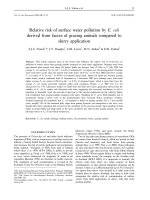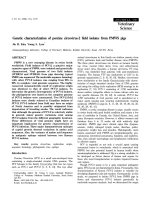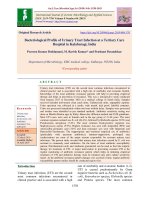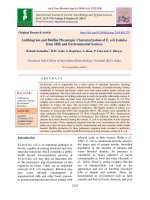Antibiogram of pathogenic urinary e.coli isolates from tertiary care hospital in Kerala, India
Bạn đang xem bản rút gọn của tài liệu. Xem và tải ngay bản đầy đủ của tài liệu tại đây (281.36 KB, 8 trang )
Int.J.Curr.Microbiol.App.Sci (2018) 7(8): 4190-4197
International Journal of Current Microbiology and Applied Sciences
ISSN: 2319-7706 Volume 7 Number 08 (2018)
Journal homepage:
Original Research Article
/>
Antibiogram of Pathogenic Urinary E.coli Isolates from
Tertiary Care Hospital in Kerala, India
Riyaz Sheriff*, K.K. Prasobh, N. Simi and A. Neena
Department of Microbiology, Azeezia Institute of Medical Sciences & Research,
Kollam, Kerala, India
*Corresponding author
ABSTRACT
Keywords
Urinary E.coli, Antibiotic
resistance, E.coli, Urinary
tract infection, Antibiotic
sensitivity profile
Article Info
Accepted:
22 July 2018
Available Online:
10 August 2018
Urinary tract infections are one of the most common causes of patient attendance in
hospitals. E.coli remains the most commonly isolated pathogen causing Urinary tract
infections. Antibiotic resistance is an emerging problem in developing countries. The way
ahead is to streamline the utilisation of antibiotics and to implement locally relevant
antibiotic policy. A total of 1152 urine samples were received during the study period. 327
samples grew monobacterial significant bacteriuria. Semi-quantitative cultures were
performed. The isolates were tested for sensitivity to the following discs Ampicillin
(10μg), Gentamicin (10μg), Tobramycin (10μg), Amikacin (30μg), Ciprofloxacin(5μg)
Levofloxacin (5μg), Cotrimoxazole (1.25/23.75μg) Amox-Clavulanic Acid (20/10μg)
Piperacillin-Tazobactum (100/10μg) Norfloxacin (10μg) Amikacin (30μg) Cefuroxime
(30μg), Ceftriaxone (30μg), Ceftazidime (30μg), Ceftazidime- Clavulanic Acid (30/10μg),
Cefotaxime (30μg) Imipenam (10μg), Tetracycline (30μg), Nitrofurantoin (300μg). The
sensitivity was recorded and reported as per the CLSI 2017 guidelines. Antibiotic
sensitivity profile of E.coli shows sensitivity to Imipenam (91%), Nitrofurantoin (97%),
Amikacin (91%), Tobramycin (72%), Piperacillin-Tazobactum (77%), Gentamicin (66%)
and Tetracycline (46%). E.coli isolated exhibited resistance to ampicillin, amoxicillinclavulanic acid, 2nd and 3rd generation cephalosporins and fluroquinolones. E.coli was
sensitive to cotrimoxazole in 49% isolates. 62 (48.1%) isolates were resistant to 3 or more
antibiotic groups (MDR). 17 of the 148 isolates exhibited Extended drug resistant (XDR)
E.coli showed high degree of resistance to cephalosporins and fluroquinolones. One of the
short term measures advised is antibiotic cycling to prolong the usefulness of live saving
drugs. For this every healthcare unit needs to develop their own antibiogram to have a
clear picture of the antibiotic resistance pattern prevalent in the area.
Introduction
Urinary tract infections (UTI) are the most
common cause of patients attending hospital.
Uncomplicated symptomatic UTI presenting
with dysuria, fever and lower abdominal pain
especially in female patients is a common
scenario in India. Urine sample remains the
most frequent sample submitted to
Microbiology laboratory for identification of
offending pathogen. The main cause of
urinary tract infection in India remains to be
the members of Enterobacteriaceae family.
This is followed by members of Pseudomonas
4190
Int.J.Curr.Microbiol.App.Sci (2018) 7(8): 4190-4197
family,
Staphylococcus
aureus
and
Enterococcus sp. Among the members of
Enterobacteriaceae Escherichia coli remains
the most important pathogen causing
uncomplicated UTI. E. coli infections are
more common in women which may be
attributed to the anatomical proximity to the
gastrointestinal tract which harbours E.coli as
a commensal (Richard Colgan and Mozella
Williams, 2011; Mohammed Akram et al.,
2007). Klebsiella pneumoniae is the next most
commonly isolated gram negative bacteria
from
Enterobacteriaceae
family.
Few
infections are caused by Klebsiella oxytoca,
Proteus mirabilis, Proteus vulgaris and
Citrobacter sp. Among the gram positive
bacteria
Staphylococcus
aureus
and
Enterococcus are responsible for few
uncomplicated UTI’s. Coagulase Negative
Staphylococci (CoNS) remain a gray area in
microbiological diagnosis of UTI. Being the
part of skin commensals CoNS are not
generally reported as an offending organism.
In the recent years there have been reports of
CoNS causing clinically relevant infections.
CoNS infections are more common in
immunocompromised population but there
have been reported studies on capability of
CoNS in causing infections in immunocompetent people as well. Members like
Staphylococcus hemolyticus, Staphylococcus
lugdunensis
and
Staphylococcus
saprophyticus are notorious in causing human
infections. The role Pseudomonas aeruginosa
in causing UTI is well known. Being a hardy
organism capable of growing on varied
substrates including disinfectants are seen pan
environmentally the isolation of Pseudomonas
aeruginosa needs correlation with clinical
condition of the patient. Nevertheless the role
of Pseudomonas aeruginosa in causing UTI
cannot be underplayed.
Antibiotic resistance has been emerging in
India (Muktikesh Dash et al., 2013). It has
reached a stage of being one of the most
important public health problems which needs
to be tackled. Since the reason for spreading
antimicrobial resistance is multi-factorial,
there needs to be coordination and exchange
of information among all those involved in
healthcare. Resistant isolates are seen both in
Enterobacteriaceae as well as in gram positive
bacteria. The most commonly isolated bacteria
are E.coli and Klebsiella. Among E.coli the
resistance to commonly used antibiotics is on
the rise. A study conducted in 2014 reports a
high degree of resistance to Ampicillin
(88.4%) followed by Amoxicillin-clavulanic
acid
(74.4%),
Norfloxacin
(74.2%),
Cefuroxime (72.2%), Ceftriaxone (71.4%) and
Cotrimoxazole (64.2%) (Niranjan and Malini,
2014). The antibiotic susceptibility data for
uropathogens in India is very minimal. There
have been very few community or hospital
based studies to assess the problem burden.
Our literature search revealed wide variations
in the resistance pattern of E.coli. The present
study was undertaken to assess the
antimicrobial susceptibility patterns of E.coli
in order to guide the clinician regarding
presumptive antibiotic usage in UTI patients.
There exists lacunae with regard to
quantification of the problem and various
determining factors related to antimicrobial
resistance. There is an urgent need to develop
and strengthen antimicrobial policy, standard
treatment guidelines, national plan for
containment of AMR and research related to
public health aspects of AMR at community
and hospital level in India (Ganesh Kumar et
al., 2013)
Materials and Methods
Freshly void mid-stream urine samples
received in the Microbiology laboratory of
Azeezia Institute of Medical Sciences and
Research from January 2017 to December
2017 were included in the study. A total of
1152 urine samples were received during the
study period. 327 samples grew monobacterial
4191
Int.J.Curr.Microbiol.App.Sci (2018) 7(8): 4190-4197
significant bacteruria. 611 samples did not
show any growth and 173 samples grew more
than 3 types of colonies and were hence
termed as mixed growth. The samples were
initially examined by wet mount. Semiquantitative cultures were performed using
calibrated loop method on 5% Sheep blood
agar and Mac Conkey agar. The plates were
incubated at 37°C for 18-24 hours.
Significance of samples was determined as per
Kass criteria (European Association of
Urology, 2013). Samples growing single
bacterial species with >105 cfu/ml were
considered as significant bacteruria samples.
Isolates were identified based on the colony
morphology, Gram staining and standard
biochemical reactions (Koneman et al., 2006;
Gerald Collee et al., 14th edn). The isolates
were then subjected to Antibiotic sensitivity
testing as per Clinical and Laboratory
Standards Institute (CLSI) 2017 guidelines
(Performance Standards for Antimicrobial
Susceptibility Testing). The Antibiotic
sensitivity testing was done on Meuller Hinton
agar. Standard strain American Type Culture
Collection (ATCC) strain of E.coli 25922 was
used as a control. The culture media were
obtained from Himedia labs, Mumbai, India
and were prepared in-house. The prepared
plates were approved for use after internal
quality control. The antibiotic discs were
obtained from Himedia labs as well. The
isolates were tested for sensitivity to the
following
discs
Ampicillin
(10μg),
Gentamicin (10μg), Tobramycin (10μg),
Amikacin (30μg), Ciprofloxacin (5μg)
Levofloxacin
(5μg)
Cotrimoxazole
(1.25/23.75μg)
Amox-Clavulanic
Acid
(20/10μg)
Piperacillin-Tazobactum
(100/10μg) Norfloxacin (10μg) Amikacin
(30μg) Cefuroxime (30μg), Ceftriaxone
(30μg), Ceftazidime (30μg), CeftazidimeClavulanic Acid (30/10μg), Cefotaxime
(30μg) Imipenam (10μg), Tetracycline (30μg),
Nitrofurantoin (300μg). The sensitivity was
recorded and reported as per the CLSI 2017
guidelines.
Results and Discussion
Among the 1152 urine samples received for
culture and sensitivity 327 samples (28.4%)
were identified as significant bacteruria
samples. 611 (53.03%) samples did not show
any growth after 24hours of incubation. These
samples were further incubated for 24 hours
and declared as culture negative at the end of
48hours. 173 (15.01%) samples grew more
than 3types of colonies after 24hours of
incubation. These samples were reported as
mixed growth along with comment to repeat
sample with Clean Catch Mid-Stream urine
(CCMSU). The predominant growth was
E.coli (148 isolates - 45.29%). 22.67%
isolated were identified as Klebsiella
pneumoniae. Gram positive bacteruria
comprising
of
Enterococcus
sp,
Staphylococcus sp and Streptococcus sp
constituted 15.90% (52 isolates). The
percentage distribution is provided in Table 1.
Gender wise, more E.coli were isolated from
female patients. Among the 148 isolates of
E.coli in significant bacteruria samples 96
isolates were from female patients and 52
isolates from male patients (Table 2). The
proportions of mixed growths were also higher
among samples received from female patients.
141 samples out of the total 1152 showed
mixed growths in females (12.23%) whereas
in males 33 samples were reported as mixed
growth (2.86%). Most of the E.coli isolates
were isolated from in-patients in our study (89
isolates). 31 and 28 isolates were obtained
from samples received from out patients and
Intensive care units respectively (Table 3).
Out of 148 isolates of E.coli 96 were obtained
from female patients. 69 out of these isolates
were from female patients admitted in the
hospital. The majority of E.coli was isolated
from samples received from General medicine
department (50.7%). The rest were isolated
from samples received from Emergency,
Obstetrics and Gynaecology, General Surgery,
4192
Int.J.Curr.Microbiol.App.Sci (2018) 7(8): 4190-4197
Urology, paediatrics and Orthopaedics
department (Table 4). In our study the Urinary
Tract Infections due to E.coli are more
common in females from the second decade of
life. In males the infection due to E.coli was
more common after 5th decade (Table 5).
First isolates of each patient were considered
for the antibiogram. 129 first time isolate
analysis showed sensitivity to Imipenam
(91%), Nitrofurantoin (97%), Amikacin
(91%), Tobramycin (72%), PiperacillinTazobactum (77%), Gentamicin (66%) and
Tetracycline (46%). E.coli isolated exhibited
resistance to Ampicillin, AmoxicillinClavulanic acid, 2nd and 3rd generation
Cephalosporins and Fluroquinolones. E.coli
was sensitive to Cotrimoxazole in 49%
isolates
The antibiotic sensitivity pattern was assessed
for Multi Drug Resistant Organisms (MDRO).
Of the 129 first time E.coli isolates 50 were
sensitive to most drugs (38.7%), 62 isolates
were resistant to at least one antibiotic in three
or more groups (48.1%) 17 strains of E.coli
exhibited resistance to most antibiotics barring
two or less groups (13.2%) and were termed
as XDR isolates (Koneman et al., 2006). We
did not come across any Pan drug resistant
strains in this study (Silpi Basak et al., 2016).
Around 150 million UTIs occur yearly on a
global basis; resulting in more than 6 billion
dollars in direct health care expenditures
Infections are rare in boys except in
association with anatomic or functional
abnormalities in the first year of life.
Infections are also infrequent among 2- to 13year-old girls, but some young girls
experience multiple repeated episodes of
recurrent cystitis or pyelonephritis. The
incidence of UTIs markedly increases among
young women during adolescence. As per the
study carried out by Prinja et al., Rs.1713 is
spent per head towards healthcare expenditure
annually (Prinja et al., 2012).
Table.1 Distribution of isolates in the urine samples (N=1152)
Isolates
Number (N=366)
Percentage (%)
148
40.44
E.coli
74
20.22
Klebsiella pneumoniae
27
7.38
Enterococcus sp
16
4.37
Staphylococcus aureus
15
4.10
Pseudomonas aeruginosa
3
0.82
Coagulase Negative Staphylococcus aureus
14
3.83
Enterobacter aerogenes
10
2.73
Acinetobacter sp
6
1.64
Streptococcus sp
8
2.19
Proteus sp
6
1.64
Citrobacter sp
12
3.28
Candida albicans
27
7.38
Candida non albicans
366
100.00
Total number of reportable growth
Non reportable growths
612
53.1
No growth
174
15.1
Mixed growth
4193
Int.J.Curr.Microbiol.App.Sci (2018) 7(8): 4190-4197
Table.2 Gender Distribution of isolates in the urine samples (N=1152)
Isolates
Number (N=366)
Males
Females
148
52
96
E.coli
74
36
38
Klebsiella pneumoniae
27
12
15
Enterococcus sp
16
2
14
Staphylococcus aureus
15
11
4
Pseudomonas sp
3
0
3
CoNS
14
10
4
Enterobacter sp
10
6
4
Acinetobacter sp
6
2
4
Streptococcus sp
8
6
2
Proteus sp
6
2
4
Citrobacter sp
12
9
3
Candida albicans
27
21
6
Candida non albicans
366
169
197
Total number of
reportable growth
Non reportable growth
612
218
394
No growth
174
33
141
Mixed growth
Table.3 Location wise Distribution of E.coli isolates
Location type
Female
Male
54
35
Inpatients (N=89)
15
13
Intensive care (N=28)
27
4
Outpatients (N=31)
Total (N=148)
96
52
Table.4 Department wise distribution of E.coli isolates
Department
General medicine
Emergency
Obstetrics and Gynaecology
Urology
General surgery
Orthopaedics
Paediatrics
Neurology
Cardiology
Pulmonology
Nephrology
Number
75
16
15
13
11
8
4
2
2
1
1
4194
Percentage (%)
50.7
10.8
10.1
8.8
7.4
5.4
2.7
1.4
1.4
0.7
0.7
Int.J.Curr.Microbiol.App.Sci (2018) 7(8): 4190-4197
Age category
<1
1-10years
11-20Years
21-30years
31-40years
41-50years
51-60years
61-70years
71-80years
81-90years
>91years
Table.5 Age-wise distribution of E.coli isolates (N=148)
Number
Percentage
Males
Females
Males
Females
1
0
0.68
0.00
2
3
1.35
2.03
0
2
0.00
1.35
0
14
0.00
9.46
0
12
0.00
8.11
1
11
0.68
7.43
13
14
8.78
9.46
11
16
7.43
10.81
13
15
8.78
10.14
10
9
6.76
6.08
1
0
0.68
0.00
This is bound to go up with drug resistant
E.coli causing UTI. E.coli is the most
common organism isolated from urinary tract
infections in India as well (Atul Kothari and
Vishal Sagar, 2008). The rate of culture
positivity is quite low in most of the studies.
In our study 611 samples out of the 1152
samples received did not grow any bacteria.
The possible explanation for this can be
incorrect timing of the sample collection or
sample may have been taken after
administration of antibiotic. In the current
scenario of over the counter medications most
patients tend to start antibiotics even before
they report to health care facility. 169 samples
were reported as mixed growth. This could be
minimized by giving proper instructions are
given to the patients regarding sample
collection (CCMSU). Secondly in our study
most mixed growth samples were seen in
females which may be due to anatomical
proximity of gastrointestinal tract to
genitourinary tract in females. Nevertheless
proper instructions on Ano-genital toilet and
proper timing of sample collection can bring
down the proportion of non-reportable culture
growths.
Among the samples showing significant
monobacterial
growth
E.coli
was
predominant. Age wise split showed that the
Urinary tract infections in female patients
were more common from 2nd to 5th decade of
life. In males the incidence of urinary tract
infections due to E.coli was more
predominant after 5th decade of life
(Devanand Prakash and Ramchandra Sahai
Saxena, 2013).
In our study E.coli showed high degree of
resistance
to
Cephalosporins
and
Fluroquinolones. This correlates with the
prescribing trends prevailing in this part of the
country. Now the million dollar question is
how to avoid resistance. There have been
many suggestions, recommendations from
international agencies (WHO and CDC).
They recommended strict control on antibiotic
use by humans. A prescription should be
mandatory for procuring the antibiotic.
Secondly the international agencies have also
called for controlled therapeutic use of
antibiotics in animal husbandry. The next
method suggested in antibiotic cycling. For
this every healthcare unit needs to develop
their own antibiogram to have a clear picture
of the antibiotic resistance pattern prevalent in
the area. Antibiotic cycling is a short term
measure to tackle antibiotic resistance and
also to prolong the usefulness of live saving
4195
Int.J.Curr.Microbiol.App.Sci (2018) 7(8): 4190-4197
drugs. This procedure will reduce the
selection pressure for resistance (Silpi Basak
et al., 2016).
The Chennai declaration documented the fact
of emergence of antibiotic resistance in India
and it aimed to form a “Road map” to tackle
the menace of antibiotic resistance in India
using a stepwise approach (Ghafur et al.,
2012). The uniform consensus was that there
is paucity of published data and antibiotic
usage and antibiotic resistance in India. The
road map included regulation of over the
counter sale of antibiotics, in-hospital
antibiotic usage monitoring and stringent
supervision on usage of life-saving drugs. It
was also decided that ICMR would set up a
National antibiotic resistance surveillance
system with representations from all parts of
the country (Magiorakos et al., 2012). The
ICMR has come out with Treatment
guidelines for antimicrobial use in common
syndromes – 2017. These were based on data
obtained from central institutes (PGIMER,
AIIMS, JIPMER, and CMC Vellore) and
available national data. These guidelines
show high degree of resistance to Cefotaxime
(72-87%), Ceftazidime (72-89%) and
Ciprofloxacin (74-90%). As per the
recommendation
issued
by
ICMR
Nitrofurantoin,
Cotrimoxazole
and
Ciprofloxacin have been suggested as first
line drugs for acute uncomplicated cystitis in
the absence of cultures. In our Study E.coli
were sensitive to Nitrofurantoin. There was
high degree of resistance to Cotrimoxazole
(55%) and Ciprofloxacin (63%). The
effectiveness of these drugs in treatment of
cystitis will have to be relooked and assessed
based on the national level data from
surveillance network.
References
Atul Kothari and Vishal Sagar. Antibiotic
resistance in pathogens causing
community-acquired
urinary
tract
infections in India: a multicenter study.
J Infect Developing Countries 2008;
2(5): 354-358.
Devanand Prakash and Ramchandra Sahai
Saxena. Distribution and Antimicrobial
Susceptibility Pattern of Bacterial
Pathogens Causing Urinary Tract
Infection in Urban Community of
Meerut City, India. ISRN Microbiology
Volume 2013, Article ID 749629.
European Association of Urology. Guidelines
on Urological infections. Urological
infection 2013. Pg. 1-108
Ganesh Kumar, Adithan, Harish, Sujatha,
Gautam Roy and Malini. Antimicrobial
resistance in India: A review. Journal of
Natural Science, Biology and Medicine.
July 2013. Vol 4. Issue 2. pg 286-291
Gerald Collee, Miles and Watt. Tests for
identification of Bacteria. Mackie and
McCartney
Practical
Medical
Microbiology. 14th edition. Pp. 113-150
Ghafur A, Mathai D, Muruganathan A,
Jayalal JA, Kant R, Chaudhary D and et
al., Recommendations of “A roadmapto tackle the challenge of antimicrobial
resistance” – A joint meeting of medical
societies of India. Indian Journal of
Cancer 2012; 49(4): 71-81.
Koneman E.W, Allen S.D, Janda W M,
Schreckenberger PC. Colour Atlas of
Diagnostic Microbiology 7th edition San
Francisco Lippin Cott., 2006 Pp. 471–
646.
Magiorakos, A. Srinivasan, R. B. Carey, Y.
Carmeli, M. E. Falagas, C. G. Giske and
et al., Multidrug-resistant, extensively
drug-resistant and pandrug-resistant
bacteria: an international expert
proposal for interim standard definitions
for acquired resistance. Clin Microbiol
Infect 2012; 18: 268–281
Mohammed Akram, Mohammed Shahid and
Asad U Khan. Etiology and antibiotic
resistance patterns of community-
4196
Int.J.Curr.Microbiol.App.Sci (2018) 7(8): 4190-4197
acquired urinary tract infections in J N
M C Hospital Aligarh, India. Annals of
Clinical
Microbiology
and
Antimicrobials 2007, 6:4
Muktikesh Dash, Sanghamitra Padhi, Indrani
Mohanty, Pritilata Panda, Banojini
Parida. Antimicrobial resistance in
pathogens causing urinary tract
infections in a rural community of
Odisha, India. Journal of Family and
Community Medicine; 2013; 20(1): 2026.
Niranjan V, and Malini A. Antimicrobial
resistance pattern in Escherichia coli
causing urinary tract infection among
inpatients. Indian J Med Res 139, June
2014, pp. 945-948.
Performance Standards for Antimicrobial
Susceptibility Testing. 27th edition.
Clinical and Laboratory Standards
Institute. Pp. 62-73.
Prinja S, Bahuguna P, Pinto AD, Sharma A,
Bharaj G, et al., (2012) The Cost of
Universal Health Care in India: A
Model Based Estimate. PLoS ONE
7(1):e30362.
doi:10.1371/journal.pone.0030362
Richard Colgan and Mozella Williams.
Diagnosis and Treatment of Acute
Uncomplicated Cystitis. American
family physician. 2011. Available from
www.aafp.org/afp.
accesses
on
September 14 2017.
Silpi Basak, Priyanka Singh, and Monali
Rajurkar. Multidrug Resistant and
Extensively Drug Resistant Bacteria: A
Study. Journal of Pathogens Volume
2016, Article ID 4065603
How to cite this article:
Riyaz Sheriff, K.K. Prasobh, N. Simi and Neena, A. 2018. Antibiogram of Pathogenic Urinary
E.coli Isolates from Tertiary Care Hospital in Kerala, India. Int.J.Curr.Microbiol.App.Sci.
7(08): 4190-4197. doi: />
4197









